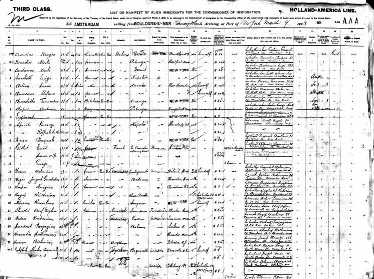
By Hrach Kalsahakian
The webpage titled “Armenian Immigration to North America through the 1930s: A Compilation of Primary Sources” authored by Mark B. Arslan provides valuable insights into the Armenian immigration to North America during the late 19th and early 20th centuries. Here is a summary of the key points:
- Armenian Immigration Background: Between the late 1800s and the outbreak of World War I in 1914, over 50,000 Armenians immigrated to North America. Most of them originated from the Ottoman Empire, specifically eastern Turkey, and arrived at New York’s Ellis Island. Some were destined for manufacturing jobs in various U.S. cities, while others sought opportunities in Canadian manufacturing towns and rich farmland in places like California’s San Joaquin Valley.
- Immigrant Profile: The majority of these immigrants were men, and many of them traveled back and forth between North America and their Armenian homeland multiple times. While predominantly traveling in 3rd class (steerage), some wives and children also joined their husbands and fathers to settle in North America.
- Historical Context: The conditions for Armenians in the Ottoman Empire deteriorated between the 1890s and 1908, leading to a significant increase in Armenian immigration to North America. This trend was further exacerbated by the Balkan conflicts of 1912-1913. However, with the outbreak of World War I in 1914, immigration slowed drastically.
- Impact of Armenian Genocide: The Armenian Genocide of 1915-1916 resulted in the deaths of many Armenians in the Ottoman Empire, leading to the depopulation of Armenian communities in eastern Turkey.
- Importance of Primary Sources: Due to the destruction of the Armenian homeland, many civil and ecclesiastical records were lost, making it challenging for contemporary Armenians to trace their genealogical and historical backgrounds. Fortunately, rich primary sources such as ship manifests, census records, World War I draft registrations, and other documents provide valuable historical information about Armenian immigrants to North America.
- Research Project: Mark B. Arslan initiated a historical research project in 2011 to transcribe the manifests of passenger ships carrying Armenian immigrants to North America. This project aims to provide a reference for those of Armenian descent in North America to identify their immigrant ancestors and learn about their heritage.
- Project Progress: As of the article’s publication, the project had abstracted 73,141 entries from 4,109 ship trips containing Armenian immigrants to North America. An online database was made available for queries and reports, with ongoing updates and a call for assistance from others interested in transcribing ship manifests.
- Immigration Details: Notably, not all individuals on ship manifest entries entered North America, as some were deported or did not board the ship. The actual number of Armenian immigrants is estimated to be around 90% of the number of ship manifest entries.
- Travel Conditions: Most Armenian immigrants traveled in steerage class, and the layout of passenger berths varied between ships, with separate sections for single individuals and families.
This research project is essential for preserving the history and heritage of Armenian immigrants to North America and highlights the need for similar research endeavors to better understand the flow of Armenian immigration in the past. Mark B. Arslan’s work serves as a valuable resource for individuals interested in their Armenian ancestry and the history of Armenian migration to North America.
